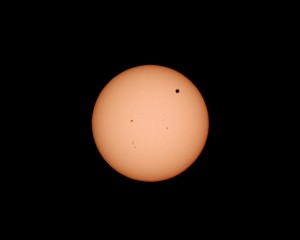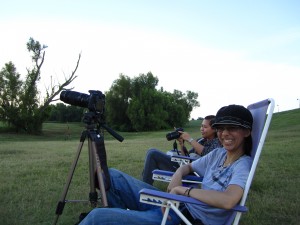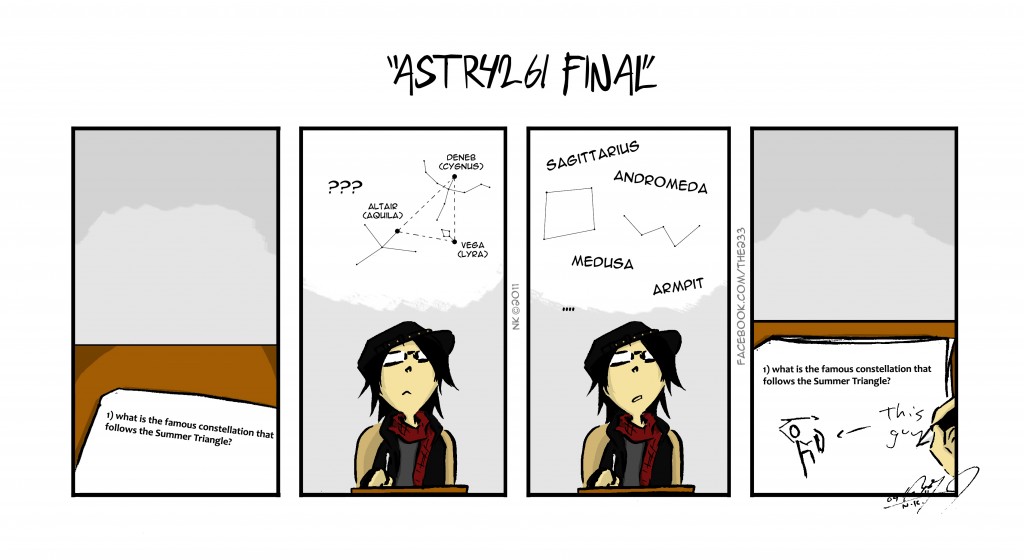Astronomy Comics
 Interesting title, you say, but what do astronomy and comics have in common?
Interesting title, you say, but what do astronomy and comics have in common?
More than I thought, actually, considering that a quick google search yielded cartoons galore filled with astronomy science and science fiction alike. I myself remember reading and re-reading Calvin and Hobbes, mesmerized and amused to the core over Calvin’s obsession with aliens, outer space, and general fantasy daydreaming. I even discovered a wiki page for “The Astronomer” “an ancient alien appearing in the Marvel Comics universe. He is one of the Elders of the Universe”. From jokes about Pluto no longer being considered a planet, to comics explaining the Higgs Boson and theories about its existence, it seems that many serious astronomers are incorporating comics as great visual elements to help readers understand their science.
Yes, it seems that comics have a long history of translating astronomy science (and fiction).
I had the pleasure of taking pictures of the 2012 Transit of Venus alongside a physics and astronomy student from Louisiana State University, who, as it happens, is a marvelous comic creator! Nutsinee Kijbunchoo not only has a mind for astronomy and the serious physics behind it, but also has artistic talents in photography, drawing, cartooning… you name it. Her comic strip, The 233, covers everything from the insanely tedious process of submitting an academic paper to funny recollections of her astronomy exams. Nutsinee, or NK, shared with me both her fantastic image of the solar eclipse as seen in Baton Rouge and a brilliant Q&A session on her life in and outside of the lab.
So, without further ado, I open the floor to NK, as she intrigues us with her research and her art!
1. Can you tell me more about your undergraduate research in physics and astronomy at LSU?
Undergrad research is a great opportunity for everyone to get to learn from the real work, real world, and not just from a classroom. My research [with LSU’s Dr. Geoffrey Clayton] has to do with dust around supernovae [stellar explosions]. We are trying to figure out how much a supernova, more specifically a type II SNe, produces dust out into the space and whether it is the main space dust contributor. Out there in the space, there're so much dust sitting around obstructing the incoming light, but nobody knows exactly what produced all that.
2. Your group studies dust in space... that sounds very interesting! How does one study dust in space, and why is this research important?
We cannot just go out in a spacesuit and grab some sample of dust then return to the earth and study them. Astronomers [depend upon incoming light for their studies]; these may include a study of a planet, a star, a supernova, even a black hole (that absorbs all the light!), including a study of dust. Dust grains absorb the high energy photons [i.e. light particles] and reemit them in infrared. And this is how we see them.
The study of dust particles is crucially important because they are sitting between us and our target objects and cause [light] extinction (stars look dimmer than they should when their incoming photons have to go through all those annoying grains). Understanding dust allow us to make precise corrections on our observed data (a Nobel prize could be depending on a few magnitudes of difference in the data. Who knows ; ) ).
3. You already have a paper published about an R Coronae Borealis star... that is very impressive! What is an R Coronae Borealis star, and what did you find out about it during your studies?
Thank you… I was impressed too that I managed to get a paper published long before my senior year (lol). An R Cor Bor (short term for R Coronae Borealis) star is a very rare type of star and has a very distinctive lightcurve. It spends most of its time at its maximum brightness, but all of the sudden the magnitude can drop down to be a very dim star, too dim to be seen even with a good telescope. What's interesting about it is that we cannot predict at all when the brightness is gonna go down. Any other star that behaves the same way is said to be an R Cor Bor as well (My paper was about an object called NSV11154). The sudden drop of the magnitude of an R Cor Bor is caused by the carbon dust formation of the star (That's what we believe happens so far). When the dust moves in our line of sight, it blocks most of the star's light and we get nothing. An R Cor Bor could be hiding behind its own cloud for many days, months, or years until the dust cloud clears out. And that's the reason why this type of star has not been observed much in the past.
What I found during my studies on NSV11154 was not only its interesting lightcurve but also its composition. While most stars [are] composed of Hydrogen (which is the fundamental element of the Universe), an R Cor Bor appears to be lacking in Hydrogen, but instead is Helium and Carbon rich, which leads to a question of where it came from. One of the projects that our group is working on is to come up with a reasonable model of how an R Cor Bor could be formed.
4. In addition to a budding career in Astronomy, you are also a fantastic photographer! When and how did you start to develop your skills for photographing the sky?
Honestly, I had never practice shooting photo[s] of the sky until the day of the transit. All I had with me at that moment was a dslr [camera], a tripod, a 70-300mm zoom lens and a bunch of useless filters that do not work with the sun at all. Though, I have been using a dslr long enough (about a year actually) to know what could be an appropriate setting for such an event, and I tried several manual settings but it did not work out (Max shutter speed, min aperture, min ISO, but the sun was just too bright at the time). Then I realized that I had a solar viewer with me that I put up to my eyes to see the transit. If my eyes could see the event, my camera which works just like our eyes should be able to see it as well. I adjusted my settings back to normal, covered the lens with my viewer and that worked out perfect.
Me: What a creative thinker!
5. But photography is not your only creative talent... I hear your write great comics, which you have contributed to the student newspaper at LSU! Tell me a bit about your comics, how you started writing them, and how you incorporate science and astronomy into your comics.
Yes, I drew some cartoons for The Reveille [LSU student newspaper] during Summer2011 and Fall 2011, and I still wish I would have time to draw some more. I started drawing comics pretty much the same time I started working with Team Clayton (Fall 2010). It's called "The 233 Comic Strip" named after the office number (233 Nicholson Hall). The 233 Comic Strip is an autobiographical comic. Meaning, what I draw is what actually happens. The comic strips capture the fun moments that happen inside the office full of (geeky) astrophysicists. I originally posted it on my personal Facebook wall just for my professor and officemates to enjoy but later I felt like I wanted to share it to other people as well, just to give outsiders an idea that an office full of scientists is not as intense as they may think (well, sometimes it could be, but not very often). I try not to put in too much hard science into my comics since I've got a very wide range of audiences; from teenagers to elders (a little bit younger than my grandfather), from non-science major [students] to professional astrophysicists. Though people seem to like it when I draw myself fighting with an IRAF script… My comic can be found at facebook.com/The233 and nk-c.deviantart.com.
Thank you for your time NK!
Who wants to draw some comic strips?


